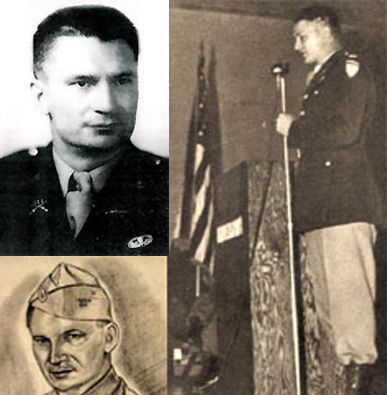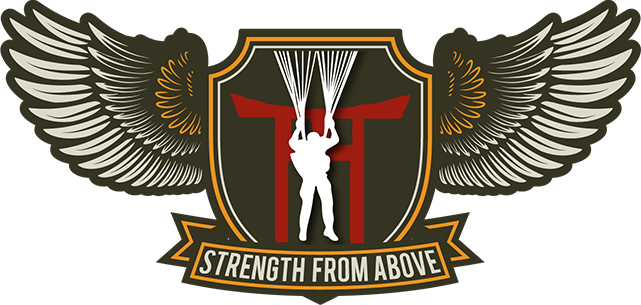This is Part 1 of our series on the legendary Colonel Orin D. "Hard Rock" Haugen #18254. You can read "Part 2: Who Was Colonel Orin D. "Hard Rock" Haugen?" by clicking here.
 While there is an unfortunate scarcity of research out there in regards to the 511th Parachute Infantry Regiment, and the 11th Airborne Division to which the 511th PIR belonged, there has been even less written or documented regarding the men who fought as Angels in World War II. While the 511th PIR served under two leaders during the war whom were greatly revered, the man who laid the foundation for the regiment's historic achievements was given an appropriate nickname for such accomplishments: Hard Rock.
While there is an unfortunate scarcity of research out there in regards to the 511th Parachute Infantry Regiment, and the 11th Airborne Division to which the 511th PIR belonged, there has been even less written or documented regarding the men who fought as Angels in World War II. While the 511th PIR served under two leaders during the war whom were greatly revered, the man who laid the foundation for the regiment's historic achievements was given an appropriate nickname for such accomplishments: Hard Rock.
Early Years:
Orin Doughty Haugen (018254) was born on August 18, 1907 in Wyndmere, North Dakota, bringing the population at the time to around 570. Orin's health was poor for much of his developmental years and as such he became a target for school bullies who often picked on the future Angel. it was during these years that Orin decided he would never back down from a fight or run away in fear, an attribute he would instill in his paratroopers nearly two decades later.
West Point to Pearl Harbor
After high school Orin attended first St. Olaf's College in Northfield, MN then Cornell College in 1925 before, at age 19, he was appointed to the United States Military Academy at West Point on July 1, 1926 where he spent four years learning what it meant to be a good soldier and an exceptional leader. For reasons Orin never fully clarified publicly, he hated his time at West Point, but he was dedicated to his pursuit and applied himself fully to the task. As such, Cadet Haugen graduated 3rd in his class with a Bachelor's of Science degree and was commissioned a 2nd Lieutenant in the Infantry on June 12, 1930.
His first posting was to historic Fort Snelling at the confluence of the Mississippi and Minnesota rivers, an assignment that was made considerably brighter when he met Minneapolis-native Marion Sargent who was the daughter of Dr. and Mrs. W. E. Sargent. After the two were married in a happy, but modest celebration on June 1, 1931, Marion dutifully accepted the life of a "soldier's wife". The young couple shared many adventures and common interests together, including horse back riding which the two were quite proficient at. In fact, the Haugens appeared in several horse shows around the Twin Cities area and Marion's horse "Whiskey" has a prominent burial site at Fort Snelling.
 By this time Orin had also become quite proficient in polo and over the course of the ensuing years would travel intermittently to play and compete for the Army. He also continued his passion for running, a habit he formed while running cross-country at West Point and one that would heavily influence the training of his future 511th Parachute Infantry Regiment (much to the men's dismay).
By this time Orin had also become quite proficient in polo and over the course of the ensuing years would travel intermittently to play and compete for the Army. He also continued his passion for running, a habit he formed while running cross-country at West Point and one that would heavily influence the training of his future 511th Parachute Infantry Regiment (much to the men's dismay).
It was somewhere around this time that, ironically, the athletic Haugen started smoking cigarettes, a habit that was common at the time and would lead to several officers who served with Orin to label him a definitive "chain smoker." In fact, when fighting alongside the paratroopers of his 511th PIR in the mountains of Leyte in late 1944, Haugen was seen searching for cigarette butts to spear with a stick to get one final puff.
On March 1, 1934, Orin was given leave then reported to the 21st Infantry Regiment posted at Schofield Barracks, Hawaii on June 2, 1934. It was here that for two years the Midwest-native got his first taste of the Pacific's mountains, jungles, heat, humidity and beaches. Orin served as Assistant Regimental Adjutant and Supply, Intelligence and Publicity Officer and was well into his education from the "Old Timers" about what it meant to be a good soldier and an officer and a gentleman. A year into his posting Orin was promoted to 1st Lieutenant on August 1, 1935 then on April 23, 1936 he was given leave before beginning the Regular Course, Infantry School on August 31, 1936, at Fort Benning, Georgia, a post that he would return to just four years later.
After completing the Regular Course in 1937, Orin and Marion headed to Fort Sam Houston, Texas to join the 23rd Infantry Division where 1LT Haugen served as a company commander and battalion executive officer. The post's heat and humidity would only further prepare him for service in the Pacific, a theater he was again sent close to in 1940 when he was transferred to Fort Ord, California to join the 32nd Infantry Regiment, 7th Infantry Division. Making the move with the Haugens was their new son, William John who was born on January 5, 1938. The young William would grow up surrounded by the military and many of the then-Colonel Haugen's future 511th PIR paratroopers remembered running with young "Pebble", William's nickname since he was the son of the "Hard Rock."
To further celebrate his move to California, on June 12, 1940 Orin was promoted to Captain and while he was respected by those under his command and the other officers he served with, Fort Ord would be a short posting since when the War Department sent an out official notice requesting volunteer officers for the new and admittedly hazardous Parachute Troops, Orin was among the first to volunteer. He soon boarded a train for a return to Fort Benning where he reported in the morning and made his first jump that same afternoon.
Orin's daring nature and tough temperament helped him fit right in with the new parachute troops and after completing his parachute training, Captain Haugen was made Commander, Company A of the historic 501st Parachute Infantry Battalion, a unit that most airborne enthusiasts easily recognize since it was the first tactical Parachute unit created by the War Department. Another company commander, also bound to make airborne history, was Orin's legendary colleague William P. Yarborough.
And as one of America's first officers to become jump certified, Orin was present for the inaugural (and somewhat tame-in-comparison) Prop Blast Ceremony on November 23, 1940. Partaking of that sacramental cup, the Miley Mug, alongside Orin was fourteen other officers and airborne legends from the 501st including as battalion commander Major William E. Miley, Cpt. William P. Yarborough, Cpt. Robert F. Sink, Lt. William T. Ryder and 1LT Benjamin H. Vandervoort.
After celebrating the holidays, the 501st's Major George P. Powell was given command of the new bare-bones 502nd Parachute Regiment Battalion in March of 1941. Forming this skeletal unit were companies skimmed from the 501st PIB and as such, Captain Orin Haugen went with Major Howell to the 502nd to slowly grow the unit into a fully-manned battalion. It was a task that taught Orin a great deal about running a parachute unit as he and Major Howell applied the lessons learned from their time with the legendary 501st.
Then on December 7, 1941, Japan's attack on Pearl Harbor changed everything.
An Angel Gets His Wings (and Command)
After war was officially declared, the first quarter of 1942 was a hive of accelerated activity at nearly every level of America's military. The War Department realized that parachute battalions lacked the strength to survive a real engagement with the enemy so it authorized the creation of an additional four parachute regiments, but a severe lack of qualified men and equipment slowed the plans. Even so, the 502 Parachute Infantry Battalion was redesignated the 502 Parachute Infantry Regiment on March 2, 1942. Major Howell was promoted to Colonel, but departed after a month to take command of Fort Benning's parachute school.
Howell's former Executive Officer Lieutenant Colonel George Van Horn Moseley, Jr. was given command of the 502nd PIR and one of his first actions was to make Orin his new XO. Moseley and Haugen labored to turn the 502nd into an elite fighting unit, one that would go on to fight in Italy, Normandy, Holland and the Battle of the Bulge. Orin would only be with the 502nd until after the activation of the 505th PIR under another airborne legend Colonel James M. Gavin who was only thirty-five years old at the time. After Orin was promoted to Lieutenant Colonel on September 25, 1942, Gavin handpicked Haugen to serve as his Executive Officer, but the assignment would not last long as on November 12, 1942 the Department of the Army issued orders to create the 511th Parachute Infantry Regiment which was initially thought would head to the European theater as an independent parachute unit, or a regimental combat team.
When Airborne Command considered who to give command of the new regiment, one name stood out form the rest: LTC Orin D. Haugen.
The Hard Rock of Toccoa
While at Fort Benning in the fall of 1942, Orin was given the news and he quickly decided his would be the best regiment in the United States Army. It was a mission that his new Executive Officer Major Glen McGowan of Chicago, Illinois, fully supported. The two carefully handpicked the men who would form the 511th PIR’s elite cadre from the 505th, 502nd and 503rd PIRs and 504th PIB (the main body was from the 505th which was at Benning at the time).
One of those young officers, the new regiment's fifth to report, was a young 2nd Lieutenant from California named Steven "Rusty" Cavanaugh. Rusty completed jump school in October of 1942 and was assigned to the 505th PIR pending the activation of the 511th PIR after New Year's. But Rusty had not completed his transfer to the infantry from ordinance, his "former life" so when Colonel Haugen's small group of new officers gathered at Fort Benning's "Frying Pan" area he noticed 2LT Cavanaugh's "Flaming Piss Pot" emblem for ordinance and Hard Rock growled, "What the hell are you doing here? You're an ordinance officer!".
While he was surrounded by incoming officers, and the existing cadre some of whom he knew, Orin was not a social commander.
"He didn't socialize much," 2LT Cavanaugh noted. "He selected some old timers he was familiar with to be company commanders, people he respected. He may have had close friends but I never knew of any."
In December the 511th's cadre moved two-hundred miles north to "a little camp outside a little town" known as Camp Toccoa, Georgia. Since the camp itself was still under construction, the cadre were told to set up shop in Toccoa's school auditorium. Then, with little warning, Colonel Haugen arrived to march his men (still in their pink and greens uniforms) up Mount Currahee's famous "three miles up, three miles down" in the red Georgia mud which made the group grateful for their jump boots.
Ever the running-enthusiast, Orin saw Currahee as the perfect physical training and testing ground for his men and after completing the grueling task, the former cross-country runner told the wheezing group of officers, "You guys are gonna run that everyday." One month later Haugen ordered roughly 40 of his officers to line up at the start of the path leading up Curraheee for a race. 2LT Steven Cavanaugh, who had finally completed his transfer from ordinance to infantry, came in third as Haugen watched.
"He didn't say anything," Rusty noted. "He was never one to tell you you'd done a good job, but he noticed. He was a great runner, he loved to run. One of my first impressions of the colonel was him soaking his feet in a pan of alum solution to toughen them."
Orin's feet weren't the only thing he wanted to toughen up. After the cadre celebrated the holidays, LTC Haugen told his supply officers that he wanted them to order enough boxing gloves for the regiment to use liberally. The thirty-five year old Orin, who had learned to stand up to bullies in his younger years, wanted his men to learn to stand and fight, first against each other then against the enemy. While the the specifics of the regiment's demanding training regime is covered in my book When Angels Fall: From Toccoa to Tokyo, the 511th Parachute Infantry Regiment in World War II, there are some interesting requirements that LTC Haugen set up before he allowed parachute volunteers to even begin that training.
Orin instructed his battalion commanders to only allow the best into the 511th. First Battalion was under the command of Maj. Ernest J. LaFlamme, Second Battalion under LTC Norman Shipley and Third Battalion under Maj. Edward H. "Big Ed" Lahti. Each was required to, alongside his aides and other senior officers, personally interview each of the volunteers who arrived via train from all over the country. We should mention that each volunteer had to appear before these interview panels standing only in his underwear (3rd Battalion's Maj. Edward Lahti had them appear naked).
Believing that his regiment would be quickly trained and sent overseas to fight in Europe, Orin set high standards that included passing the Army General Classification Test with a score of 110 or higher, possessing an IQ of at least 100, and impressing the interview board enough to be accepted. The final test was a run up Currahee Mountain and of 12,000 volunteers, only 35% met Hard Rock's requirements; the other 65% were rejected and sent elsewhere which prompted the War Department to write Colonel Haugen a censuring letter, stating that his selection process was too stringent. Orin just laughed it off, declaring, "They were too late."
The remaining 3,000 men (this number would be further whittled down before heading overseas) quickly came to see Colonel Haugen as a mixture of fair discipline, a stern demeanor, passionate drive, strict regulations, consummate professionalism and boundless energy. Orin often led the still-forming regiment on runs up Currahee which prompted several paratroopers to tell me, "I thought to myself, 'If that old bastard can make it up this hill, so can I!'". Though countless troopers admitted to detesting all the physical training at Toccoa, they later understood that Orin was just trying to prepare them for the front.
On January 29, 1943, Hard Rock wrote to his men, "This is a challenge to every man in this Regiment to meet the tests and so called hardships you will undergo here in preparing yourselves for combat. When the bullets start flying you will know that you are physically tough and mentally prepared for the shocks and real hardships of War."
While he pushed his men hard, one should not assume that Orin didn't care for his men. As a career soldier, Hard Rock had started at the bottom and wanted his officers to remember their own journeys. He constantly reminded his leaders that they should always put the welfare of their men foremost and to lead by example. When jump training began, officers were to jump out the door first, eat last, share the load by occasionally carrying machine guns or mortar tubes on marches and check their men’s feet for blisters.
Orin also drilled home a somber message to his junior officers: "When you leaders fail to accomplish your mission, you are responsible for all the men you lose."
But perhaps most telling of all regarding his leadership style, as Orin's wife Marion told their young son William, "He never asks the men to do something he isn't willing to do himself."
Leaving Camp Toccoa
The routine at Toccoa changed very little until on March 21, 1943, seventy-five days after the 511th was activated, I Company, the last element of the fully formed regiment, boarded its train for Camp Mackall, North Carolina, the home of Airborne Command’s new headquarters. Col. Haugen’s men were headed to join the 11th Airborne Division, the Angels.
Stay tuned for Part 2 of this series that will cover Orin's experiences from Camp Mackall to Fort Benning, then Camp Polk and finally Camp Stoneman. Part 3 will discuss the regiment's time on New Guinea before they fought their bloody campaign on Leyte. Part 4 will cover the Luzon campaign as well as Orin's mortal wounding on February 11, 1945 during the Battle for Manila.
To learn more about Colonel Orin D. Haugen and his historic regiment and the intrepid men who fought in it, you can order Jeremy C. Holm's new book, WHEN ANGELS FALL: From Toccoa to Tokyo, The 511th Parachute Infantry Regiment in World War II by visiting our online store or purchasing a copy wherever books are sold.


